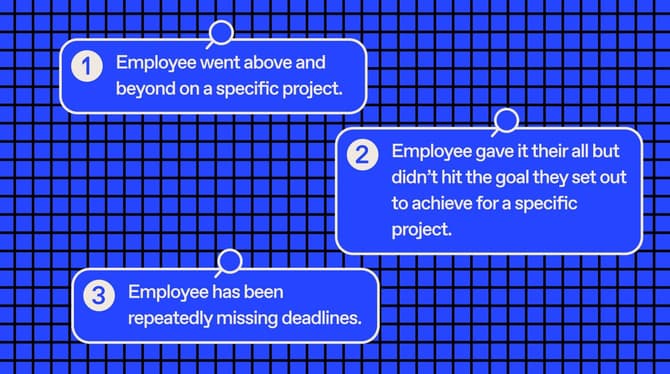Employee turnover is a white-hot topic these days — and with good reason. According to a recent study by McKinsey, around 40% of employees surveyed considered leaving their jobs for greener pastures within the year. And as the battle for talent rages on, companies are looking to adapt their employee experience strategies to keep their people around for the long haul.
A certain amount of turnover is to be expected at every company. But as an HR leader, you want to avoid losing your top performers by reducing employee turnover on your team. The first step is to learn how to calculate employee turnover and understand your turnover rate. From there, you can take active steps to improve your retention rate, which is the other side of the coin.
Exclusive online summit
·
May 23 2024
Moments that matter: how to seed great work
What's in this article
What is the employee turnover rate?
Employee turnover refers to the number or percentage of people who leave an organization during a specific time period (typically one year) and are replaced by new employees.
Turnover can be divided into two categories: voluntary and involuntary. The former refers to employees who decide to leave their positions for new opportunities at a different company, different department, or for retirement. Involuntary turnover, on the other hand, occurs when an employee is asked to leave the organization for a number of reasons, including lackluster performance, problematic behavior, or significant misalignment with the company culture.
Why should HR calculate employee turnover?
Saying goodbye to a colleague is always tough, regardless of how they left. But after employees leave, the fact remains that there might be significant gaps in projects and implications to consider for the rest of the team.
Replacing employees can put a financial strain on an organization. These hard costs are quantifiable and are usually the biggest considerations for C-suite leadership when calculating employee turnover rates.
According to a 2019 Gallup study, it can cost a company one-half to two times the employee's annual salary to replace them. If the average employee earns $50,000 annually, your organization may be dishing out anywhere between $25,000 to $100,000 to replace them.
The biggest hard costs of employee turnover include:
- Offboarding costs
- Hiring costs
- Onboarding new hires
- Training new employees
- Benefit costs
But the costs extend far beyond the dollars and cents, though; these more subtle but equally important ones are called soft costs. If you have high turnover, your team could experience the true employee turnover cost in ways like:
- Lower engagement and morale: People leaving the team can impact team spirit for active employees. Saying goodbye to colleagues, disrupting regular teamwork cycles, and taking time out of your team’s calendar to help with backfilling roles on your team can all lead to employee disengagement if it’s happening too regularly.
- Fear and uncertainty: When people frequently leave your team, employees might wonder if they should leave, too. People might even fear that they could be next to be let go. This kind of uncertainty can cause your employees to lose trust in management and leadership. It can also cause your employer brand to take a serious hit.
- Decreased productivity: Work gets shuffled around and projects are impacted when someone leaves the team. And when employees go, they take valuable skills and knowledge with them. This can even lead to burnout, as team members who stay start taking on extra work.
You can’t always stop employees from leaving. However, knowing your company's turnover rate will help you identify any problems that might be happening on your team. If you notice that people are leaving your team at a more-than-regular rate, you can spend some time understanding why, and work on your employee retention strategy.
How to calculate employee turnover
Annual employee turnover rate
Math doesn't always come easy to everyone, but it’s important to understand how to calculate turnover. Follow these steps to measure turnover.

Step 1: Add the number of employees at the start of the year with the number you had at the end of the year.
For example: 20 employees at the start of the year + 18 employees at the end of the year = 38 employees.
Step 2: Divide the total you got from step one in half (by 2).
For example: 38 total employees ÷ 2 = 19 employees.
Step 3: Divide the number of employees who left during the year by the outcome of the first equation.
For example: 2 employees left during the year ÷ 19 employees = 0.105
Step 4: Multiply this final number by 100, and you‘ve got your employee turnover rate.
For example: 0.105 × 100 = 10.5% turnover rate.
Monthly employee turnover rate
If you want to keep a more active pulse on this number, you can calculate your turnover rate more often in a certain period. All you have to do is follow the same equation, but with shorter time intervals, such as bi-annually or quarterly. Checking in on your monthly turnover rate can also be a good approach.
According to SHRM, you can follow these steps to calculate the monthly turnover rate at your company:
- Determine the number of employees who have left during the month.
- Take the number of departures and divide it by the average number of employees who are active.
- Take that result and multiply by 100.
- Voila! Your monthly employee turnover rate.
Here is a quick example:
Five employees left in October and the average number of employees at your company is 80.
5 ÷ 80 = 0.0625
0.0625 × 100 = 6.25%
Your average turnover rate for that month is 6.25%.
What is a good employee turnover rate?
When it comes to employment data, it’s hard to pinpoint a golden number or benchmark. You need to look at your employee turnover rate from a few different lenses to get a real sense of what it means to you.
An average employee turnover rate hovers around 18%. This includes both involuntary and voluntary turnover. However, a turnover rate of 10% or less is what most companies consider a healthy turnover rate.
Understanding your team’s turnover rate
Remember, there is more to this number than meets the eye. It’s crucial that you contextualize your turnover rate within the reality of your team and organization.
Who are the employees that are leaving? Why are they seeking out other opportunities in other industries or companies? Addressing the root causes of your voluntary turnover can help you make improvements to the employee experience after you part ways with a colleague.
Some of the most common causes of employee turnover include:
- Inflexible workloads and schedules
- Lack of professional development opportunities
- Murky understanding of roles
- Burnout and disregard for employee well-being
- Misalignment of values
Making time to calculate employee turnover on a regular basis is one way to understand employment patterns and engagement levels on your team. Consider calculating your turnover rate at the end of each quarter, so that you can have a fluid and up-to-date comparison over time. You might spot trends from seasonality or company changes that could give you valuable insights into what contributes to employee turnover.
If you’re experiencing turnover because people are leaving the organization and you’re not sure why — or if everyone is citing the same reasons for their departure — this could be a red flag.
Another good way HR leaders can better understand their team’s turnover is to ask. Make sure you have an exit interview for every employee departure. This can be a formal or informal discussion with a departing employee to get a sense of what led them to make the jump and whether they have specific feedback to impart.
Better yet, conduct a stay interview if you're sensing that an employee may be thinking of leaving and address the reasons why they are considering moving on.
Pro tip: Don’t just wait until people are packing up their desks, you can also ask employee retention questions to your team to understand the employee experience. Get to know what’s keeping them happy, engaged, and motivated at work.
Lower your turnover rate with proven strategies
If your company is experiencing an undesirable annual turnover rate, it might be high time to adapt your engagement and retention strategies to keep your people happy.
Collect (and act on) employee feedback
Taking a regular pulse of your employees is primordial to the success of any business. Check in on your teams by asking them the right questions to get to the heart of what matters most to your people. But remember, if you collect feedback, it's vital to act on it. Feedback may uncover challenges on your teams, but this is a great opportunity to work in tandem with your people leaders to improve the employee experience.
Create a culture of recognition
Building a culture of recognition means more than just celebrating big wins — it's about highlighting the valiant efforts regardless of outcomes. Employees want to know that the hours and energy they put in are being noticed. Receiving recognition instills a sense of pride and will go a long way in keeping employees engaged and happy with their work.
Hold frequent one-on-one meetings
We've said it before and we'll say it again: check in on your people. By holding regular one-on-one meetings, you and your managers are creating a safe space for your employees to share their thoughts and concerns and ask questions on everything from salary to project clarity. While team meetings serve a specific and important purpose, knowing when to chat privately with an employee who might need a hand is a mark of good leadership.
Offer professional development opportunities
Most people want to grow within their companies and will seek out other opportunities if not given the chance to flourish. Tap into your talented team's interests and provide career development opportunities like workshops, lunch & learns, or even language courses.
Lean on trusted tools
Like tracking engagement metrics or asking for feedback from your team, calculating turnover is one more tool you can use to understand what matters to your employees. But you don't have to go at it alone; employee engagement solutions like Officevibe make it easier than ever to take the pulse of your team.
By practicing active listening and putting in the hours to make changes, you can keep your top talent engaged and committed to your organization for a long, happy time.



